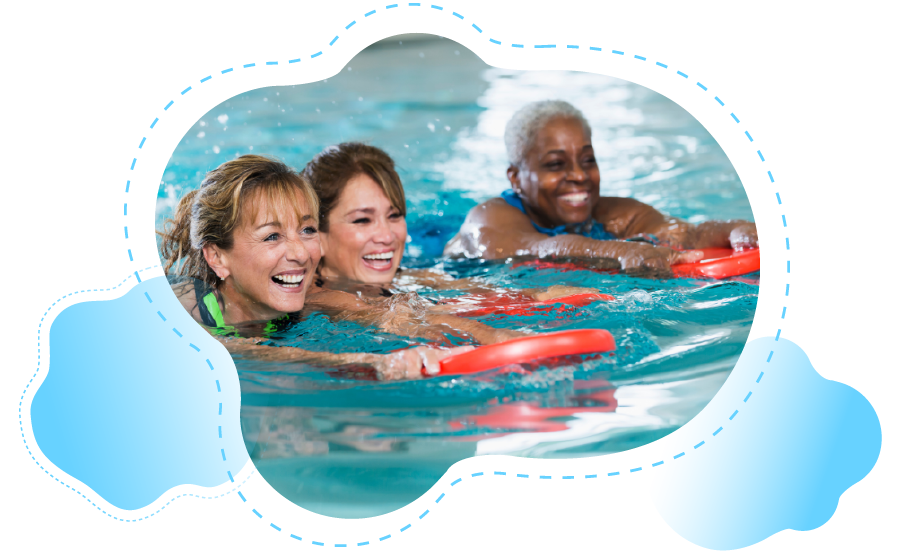For many people who are looking to increase their physical activity levels figuring out where to start or which activity to choose can be daunting. Self-doubt can easily creep in and derail the best intentions. You may find yourself wondering ’What will the neighbours think?’ ‘What will my friends think’? ‘How much should I do?’, ‘How do I know if I’m using this piece of equipment right?’ If you’re like most people you’ll go to the web, Google lots of topics, and be more confused than before. You may even give the whole idea away before you have had a chance to start. So, what can you do to give yourself the best chance at success? Here is a simple step-by-step approach I used almost daily in my clinical practice to help people start, and stick with, physical activity.

Step 1: Think about what you are trying to achieve.
Now most people will say weight loss, but rarely do people who try to lose weight through physical activity have short term success, or keep it off in the long term, or even feel happier when they achieve their goal. Instead, they realise that weight loss isn’t always associated with making them feel better. So rather than a fixed goal of wanting to lose a set amount of weight, think more deeply about what will make you happier.
“Think about some of the things you want in your life that can be made easier through physical activity. Things like having more energy, being able to play with the children or grandchildren, climbing a flight of stairs with less effort, or mowing the lawn without having to stop.”
Granted, these things aren’t as easy to measure, but one thing I observed in so many clients I saw in my clinic was they felt better, even when clinical markers like weight, waist measurement, some blood measurements, or even recovery from an injury didn’t occur to the extent people expected. There’s something about regular physical activity that just makes you feel good, and there is a wealth of scientific evidence that supports this (1). In turn, this helps with mental health. Anxiety can lessen, depression can reduce, and even more serious mental health conditions can be helped by regular physical activity (2, 3).
Step 2: Choose an activity you enjoy.
People gravitate to things they enjoy. It makes perfect sense! Find an activity or a range of activities that you enjoy, are safe, feasible to do, and will bring you back to do them again. Make a list of these activities and keep it handy! Think of it like a toolbox. It’s full of tools (your physical activity options) even though you won’t need them all every day. You can choose the physical activity option that suits your mood, interest, or abilities, on any given day. Sometimes you’ll need to add more tools to your toolbox, as the ones you already have may not do the job (ask anyone that shops at a hardware store; you can never have too many tools!). So, if resistance training is in your toolbox, but you never use it, that’s fine. You may not need it today, or next week, but there might be a time, particularly as we age, when resistance training becomes more important. The point is, you can’t do everything, but you are much more likely to do more of what you enjoy (4).
Step 3: Treat potential hurdles as opportunities.
It’s important to accept that sometimes things are going to get in the way of your plans. Like any part of life, barriers to participating in physical activity just happen! Children get sick, you get sick, we get tired, our bodies change as we age.
“If you let these barriers stop you from enjoying the benefits of physical activity, then you’re not being fair to yourself. Instead, see these as opportunities for variety or to do something different.”
For example, you usually go for a walk, but today it’s raining. It’s your choice; not go for a walk and feel bad that you missed a session or try an alternative. That might include going to the shopping centre and walking for the same amount of time (stopping to actually shop doesn’t count!), doing step ups at your house, walking around under the house, doing some resistance exercises instead – there is no shortage of options. So, look at barriers as opportunities and be confident that in the long-term scheme of things it’s more about doing something, than doing the same thing or the ‘right’ thing (5).
Is increasing your physical activity the best change to make for your health right now? Here are four quick questions to help you decide.
- Am I ready to make this change? You could rate this on a 0-10 scale with 0 meaning ‘absolutely not’ or ‘definitely not now’, and 10 meaning ‘Yes definitely’ if you score 7 or less, maybe now isn’t the best time to choose physical activity as the health behaviour to change and something else like diet or stopping smoking (if you’re a smoker) might be more successful.
- How important is it for me to make this change? This is a key question because if something isn’t very important, then you’re not likely to put much effort into changing and not likely to see any benefit. Using the same 0-10 scale with anchors at 0 = ‘not important at all’, and 10 being ‘very important’, then if you’re at 7 or better, you’re good to go.
- Am I confident I can make this change? Self-doubt is normal for anything new. But of you score 7 or better here, between 0 = ‘not at all confident’, and 10 = ‘super confident’ then you’re likely to be successful.
- Do I have the knowledge to do the ‘right’ thing and do I know what the benefits will be. Sometimes, even more importantly, it’s good to consider, do I know the consequences of NOT making this change. For this point, talking to a health professional might be of benefit.
Overall, the information here isn’t a blueprint for what to do, or what’s best for you, because everyone is different. Rather it provides an opportunity for self-reflection. It’s your health and your physical activity, so you’re in charge. If you have any questions about your health and what’s best for you, talk to your Doctor or health professional.
Here are some additional resources that might be of interest:
- Exercise and Sports Science Australia: www.essa.org.au
- The Readiness Ruler: https://www.flindersprogram.com.au/wp-content/uploads/Readiness-Ruler-v2.jpg
- Physical activity – How to get started: https://www.health.qld.gov.au/news-events/news/start-exercise-goals-guide
About the Author
Rob Stanton is an Associate Professor in the School of Health, Medical and Applied Sciences for CQUniversity. He is Chair of CQUniversity’s Human Research Ethics Committee, co-leads the Research Cluster for Resilience and Wellbeing, is Head of Course for the Bachelor of Science (Honours), lectures in the Exercise and Sports Science course, and co-champions the RHD Supervisor Community of Practice. His industry engagement includes roles with Exercise and Sports Science Australia as Chair of Publications Committee, with Central Queensland Hospital and Health Service through the Research Ready Grants Program., and the development of fact sheets for Exercise is Medicine Australia.
His primary research interests include exercise for the prevention and treatment of mental health conditions, physical health care of people with mental illness, and mental health literacy. Rob collaborates primarily with researchers at CQUniversity, UNSW, UWA and UoN. His Exercise and Mental Illness Questionnaire developed during his PhD is widely used to examine how health professions consider exercise in the care of people with mental health conditions and has been translated into 5 languages.

References
- Chan JSY, Liu G, Liang D, Deng K, Wu J, Yan JH. Special Issue – Therapeutic Benefits of Physical Activity for Mood: A Systematic Review on the Effects of Exercise Intensity, Duration, and Modality. The Journal of Psychology. 2019;153(1):102-25.
- Firth J, Solmi M, Wootton RE, Vancampfort D, Schuch FB, Hoare E, et al. A meta-review of “lifestyle psychiatry”: the role of exercise, smoking, diet and sleep in the prevention and treatment of mental disorders. World Psychiatry. 2020;19(3):360-80.
- Ashdown-Franks G, Sabiston CM, Stubbs B. The evidence for physical activity in the management of major mental illnesses: a concise overview to inform busy clinicians' practice and guide policy. Current Opinion in Psychiatry. 2019.
- Teixeira DS, Rodrigues F, Cid L, Monteiro D. Enjoyment as a Predictor of Exercise Habit, Intention to Continue Exercising, and Exercise Frequency: The Intensity Traits Discrepancy Moderation Role. Front Psychol. 2022;13:780059.
- DiPietro L, Al-Ansari SS, Biddle SJH, Borodulin K, Bull FC, Buman MP, et al. Advancing the global physical activity agenda: recommendations for future research by the 2020 WHO physical activity and sedentary behavior guidelines development group. Int J Behav Nutr Phys Act. 2020;17(1):143.
The Activate Your Everyday Series is proudly supported by the Queensland Government and Health and Wellbeing Queensland through ActiveKIT Round 2
